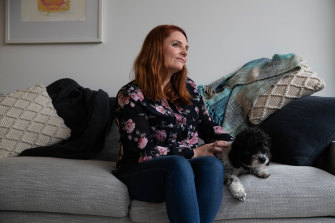Nearly 200,000 people have filed for divorce across Australia in the past two years, the highest number in more than a decade, as relationships succumb to extended lockdowns and other COVID-related stresses.
The Sun-Herald and The Sunday Age can reveal the Federal Circuit and Family Court of Australia received 47,016 divorce applications during the 2021-22 financial year, which ended on Thursday. That came on top of 49,625 in the previous financial year.
It marks a big rise from the 2019 financial year, the last full year before the Black Summer bushfires and the pandemic, when there were 44,432 divorce applications. Each application represents two people.
Relationships Australia NSW chief executive Elisabeth Shaw, commenting on the national trend, said the pandemic brought a lot of stress and conflict, and also forced couples to spend time together and face problems that might have been “on a slow burn” previously.
“People were thrown together when they normally might be distracted by busy lives and being outward-focused,” Shaw said.
“Some couples and families did really well, they surprised themselves with really heartwarming moments where it was like a rekindling and a reevaluation of the goodness that they have together. Others felt like all the chips were really down, and they couldn’t rely on their partner and there was nothing left for them.”
The highest number of divorces was 1976, after no-fault divorce took effect in Australia. Australian Institute of Family Studies researcher Dr Lixia Qu said the highest divorce rate for the married population besides 1976 was in 1996, which she attributed to the stress of the early 1990s recession.
Qu said the current rise was not surprising given the past two years saw “some people really struggling financially … and people working from home and remote schooling”.
The court figures represent all divorces in Australia, except those in Western Australia. Divorces are registered by the court, even when the financial settlement and parenting arrangements are agreed upon separately.
However, it does not reveal the divorce rate because this depends on the underlying number of marriages in the population.
It also ignores separations of de facto relationships, which are increasingly common.
The 2021 census data released by the Australian Bureau of Statistics last week revealed 11.5 per cent of people over the age of 15 are in a de facto relationship. This has risen from 9.4 per cent in 2011 and 10.4 per cent in 2016.
The Separation Guide chief executive Angela Harbinson estimated the true divorce numbers were double, when you included separations of de facto relationships.
Harbinson said a policy response was warranted to offset the negative effects of separation and divorce, including “higher rates of crime, suicide and depression, long-term poverty and workplace productivity losses”. Using methodology from a British study, she estimated the societal cost to Australia was $860,000 a year.
The census showed 46.5 per cent of the population aged over 15 is married, down from 48.1 per cent in 2016. Divorcees account for 8.8 per cent of the population, while 36.5 per cent have never been married, both up from 2016.
There are now more than a million one-parent families, representing 15.9 per cent of all families compared with 14.5 per cent 25 years ago.
Bec Chappell, photographed with her dog Alfie, split up from her husband during the pandemic.Credit:Janie Barrett
Bec Chappell, 34, from Castle Hill in Sydney, separated from her husband at the end of 2020. He told her he was unhappy in the relationship in January, before the pandemic hit Australia, and they stayed living together during lockdown.
“As we were going to bed one night he said, ‘I don’t think I want to be with you any more,’ and I said, ‘OK, that’s fine, I don’t want to be with someone who doesn’t love me,’ ” Chappell said.
“In hindsight my reaction definitely shocked me and told me more about where I was in the relationship too.”
The couple had been together for 10 years and married for three, but did not yet have children. Chappell has a new love interest but first took the time to get to know who she was as an individual before rushing into another relationship.
Divorce coach Carla Da Costa, who works with clients nationally to help them with the practical and emotional aspects of separation, said she had a steady stream of clients during the pandemic and most were from Sydney and Melbourne where they experienced the longer lockdowns.
“Most inquiries and new clients are coming to me expressing that the lockdown forced them to reassess their relationship,” Da Costa said.
“A lot of people were really on that hamster wheel of life and distracting themselves with taking children back and forth to school, their careers, and outside hobbies and social life.”
Da Costa said the new generation was less likely to settle for unsatisfying relationships and could find fulfilment after divorce in “a second chapter of life”.
This was the case for Melbourne woman Lauren Cox, 44, who is using a pseudonym.
Cox, who was married for two decades and has two school-aged sons, said the pandemic heightened her dissatisfaction with her role in the family.
“I felt like I was being taken for granted almost as not just the homemaker but the doer of everything at home with the kids and cooking and all of that … there was an underlying expectation that I would pick up the little bits and pieces,” she said.
The couple tried counselling but “it felt awkward and too far gone” and they separated in 2021. Cox said if it hadn’t been for the pandemic, they might still be together – but she thinks they wouldn’t be as happy as they could be separated.
The Morning Edition newsletter is our guide to the day’s most important and interesting stories, analysis and insights. Sign up here.
Most Viewed in National
From our partners
Source: Read Full Article



